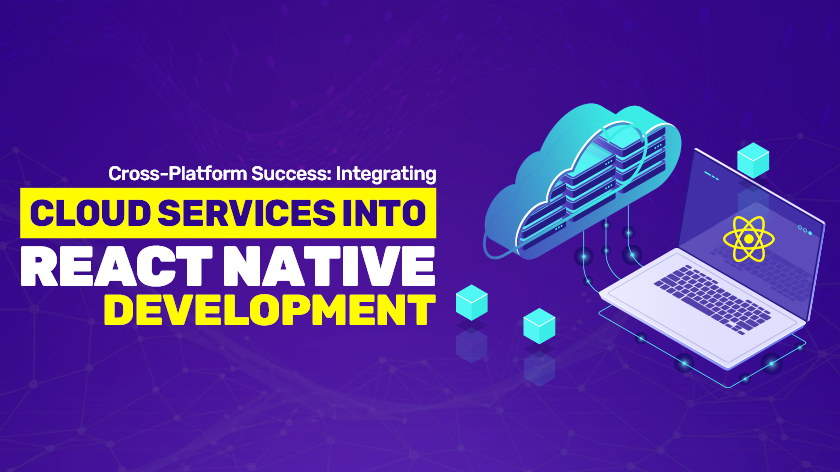React Native framework With this, developers can now write code once and run it on multiple platforms. However, integrating cloud services with React Native development enhances scalability, security, and performance even further. In this blog, we’ll explore the benefits of combining React Native with cloud services and how this integration drives success in cross-platform projects.
Why cloud services?
Cloud services like Microsoft Azure, AWS, and Google Cloud give developers strong tools to improve their products. With having to manage actual servers, developers can use cloud technologies to create apps that are more dependable, secure, and scalable. The adaptability of cloud platforms allows for real-time updates, data storage, and processing capacity, all of which enhance the total efficiency of apps.
The Benefits of Integrating Cloud Services with React Native
- Scalability and Flexibility: Cloud services enable apps to scale effortlessly as user demand increases. Whether you’re experiencing a sudden spike in app usage or planning for future growth, the cloud offers dynamic scalability. Integrating this with React Native allows developers to ensure their apps can handle fluctuations in traffic across platforms without requiring manual intervention.
- Seamless Data Synchronization: Apps often need to sync data across different devices in real time. By integrating cloud services, you can ensure that data is consistent across all platforms, whether users are on iOS or Android. With cloud-based databases like Firebase or AWS DynamoDB, data is synchronized in real-time, providing users with up-to-date information no matter which device they use.
- Cost-Effective Development: Cloud platforms often operate on a pay-as-you-go model, meaning developers can scale resources based on the app’s current needs. This reduces the upfront infrastructure cost, especially for startups or small businesses developing cross-platform apps. By combining cloud services with React Native, developers can focus on building user-friendly apps without worrying about infrastructure overhead.
- Enhanced Security: A mobile app’s security should always come first. Built-in safety features from cloud service providers include passwords, multi-factor authentication, and respect for international security standards. By incorporating these services into your React Native application, you can take advantage of regular security protocol changes and guarantee the protection of important user data.
- Faster Time to Market: React Native speeds up development by enabling code sharing across platforms. When paired with cloud services, developers can further accelerate the development process by using pre-built APIs and cloud functions. For example, using AWS Amplify or Firebase’s backend services eliminates the need to build backend infrastructure from scratch, allowing apps to be deployed faster.
Popular Cloud Services for React Native Development
- AWS Amplify: AWS Amplify simplifies backend integration for React Native apps. It offers services like authentication, APIs, real-time data, and storage. With its easy-to-use libraries, Amplify enables developers to quickly integrate cloud features without worrying about infrastructure management.
- Google Firebase provides a comprehensive suite of services, including real-time databases, authentication, analytics, and cloud messaging. It’s a popular choice for React Native developers due to its seamless integration and robust support for cross-platform development.
- Microsoft Azure: Azure offers a scalable cloud platform along with robust tools and APIs for developing mobile applications. React Native apps may be readily linked with Azure’s cloud services, storage, and machine learning capabilities to provide advanced features like automation and AI-driven insights.
How to Get Started
It takes careful preparation and a solid grasp of both the cloud provider and React Native’s architecture to integrate cloud services with React Native. Here’s a thorough guide to help you on your way:
- Select the Correct Cloud Provider: Make sure the cloud solution you choose has the functionality your app needs. Popular choices with particular capabilities created especially for mobile apps are AWS, Firebase, and Azure.
- Set Up Cloud Services: After selecting your cloud provider, set up the necessary services, such as authentication, database, and storage. Most providers have extensive documentation to guide you through the setup process.
- Integrate Cloud SDKs into React Native: Cloud providers offer SDKs that simplify the integration process with React Native. Install these SDKs and configure them in your app to start using the cloud services.
- Build and Test: With cloud services integrated, build your app and test its functionality across platforms. Ensure data sync, security, and performance meet your app’s requirements.
- Deploy and Monitor: Once the app is built, deploy it to the appropriate app stores. Cloud platforms offer monitoring tools that allow you to track usage, performance, and security post-launch, ensuring the app continues to meet user expectations.
Conclusion
Integrating cloud services into React Native development offers a multitude of benefits, from improving scalability and security to speeding up the development process. As businesses strive to deliver feature-rich, cross-platform apps, the combination of React Native and cloud services is a powerful strategy for achieving success. By leveraging cloud platforms, developers can focus on innovation and user experience while ensuring their apps are built for the future.
Are you ready to unlock the full potential of React Native apps with seamless cloud integration? Start your cross-platform success journey with XcelTec today!
For more information: https://www.xceltec.com/
 :
https://in.pinterest.com/xceltec0192/
:
https://in.pinterest.com/xceltec0192/












